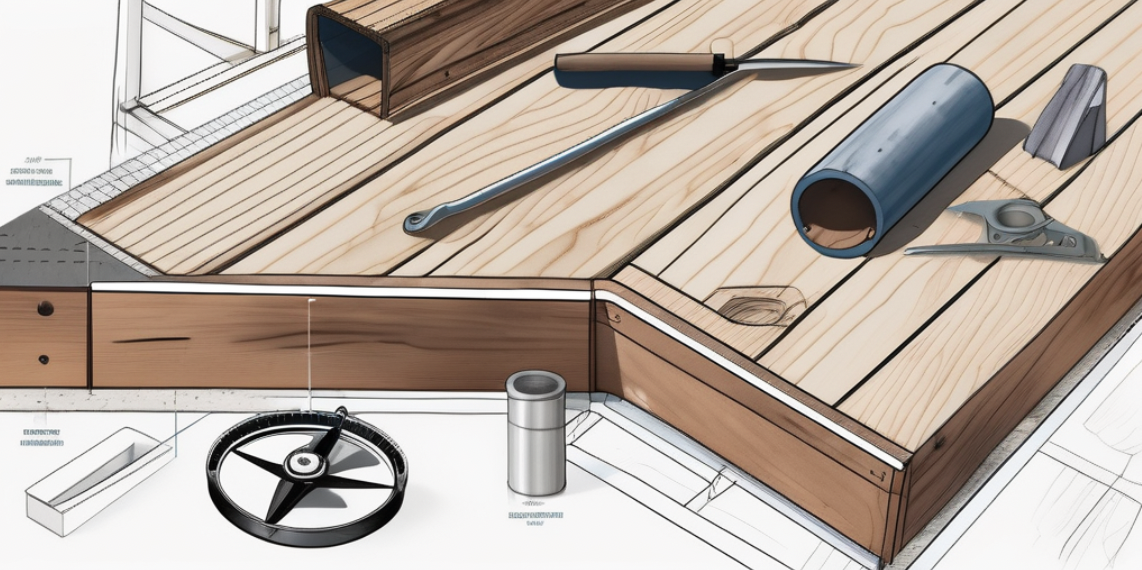Discover how to create the ultimate outdoor oasis with our comprehensive deck planning guide and material selection tips.
Creating the perfect deck for your home is an exciting venture. Not only will it enhance your outdoor living space, but it will also increase the value of your property. However, building a deck requires careful planning and consideration. With our comprehensive deck planning guide and material selection tips, you’ll be well-equipped to embark on this rewarding project.
Understanding the Basics of Deck Building
Before diving into deck planning, it’s essential to understand the fundamentals of deck building. Please familiarize yourself with the different types of decks, such as freestanding or attached decks, and their respective advantages and considerations. Learn the concept of deck load capacity to ensure the structural integrity of your deck.
Next, educate yourself on the various materials used in deck construction. Each option has pros and cons, from traditional wood to composite materials. Consider durability, maintenance requirements, and aesthetic appeal when selecting the ideal material for your deck.
It’s crucial to understand the importance of proper deck drainage. Ensuring that water can efficiently drain off your deck will prevent issues such as rot, mold, and mildew. Incorporating a slope into your deck design and utilizing materials that promote water runoff can significantly extend the lifespan of your deck.
Don’t overlook the significance of deck lighting in both functionality and ambiance. Strategically placed lighting fixtures can enhance safety by illuminating stairs and walkways and creating a warm and inviting atmosphere for evening gatherings. Explore options such as solar-powered lights for eco-friendly solutions or low-voltage LED lights for energy efficiency.
Understanding Your Deck Needs and Budget
Every deck project is unique and tailored to the homeowner’s specific needs and preferences. Take the time to evaluate how you plan to use your deck. Will it be an entertainment space for hosting family and friends or a quiet retreat for relaxation? This initial step will help you determine your deck’s size, layout, and additional features.
Establishing a budget is a crucial component of deck planning. Determine how much you are willing to invest in your deck, factoring in materials, labor, and any additional expenses. Setting a realistic budget allows you to make informed decisions during the planning and material selection process.
When considering the use of your deck, consider the climate in your area. If you live in a region with extreme weather conditions, such as heavy rain or intense sunlight, you may need to invest in durable materials that can withstand these elements. Additionally, incorporating features like a pergola or awning can provide shade and protection, enhancing the usability of your deck throughout the year.
The layout of your deck plays a significant role in its functionality. If you envision hosting large gatherings, allocating space for outdoor furniture and seating arrangements is essential. On the other hand, if you prefer a cozy retreat, integrating elements like built-in benches or a fire pit can create a warm and inviting atmosphere for relaxation.
Step 1: Assess Your Property and Obtain Permits
Before commencing construction, assess your property to identify the best location for your deck. Consider factors such as sun exposure, privacy, and access to the house. Once you’ve determined the ideal spot, check with your local building department regarding permits and any building codes you must adhere to.
When you obtain the necessary permits, you’ll ensure that your deck is built safely and compliant with regulations, providing peace of mind and avoiding potential legal issues.
Step 2: Design Your Dream Deck
Now comes the fun part – designing your dream deck! Sketch out your deck planning design, considering elements such as the shape, levels, and additional features like built-in seating or outdoor kitchens. Take into account the overall aesthetics, but also prioritize functionality and usability.
If unsure about the design, consult a professional deck builder or use deck design software to visualize different options. These tools can help you make informed decisions and ensure your deck meets your expectations.
Step 3: Determine the Decking Material
Choosing a suitable decking material is essential for achieving your deck’s desired look and longevity. As mentioned, consider factors like maintenance, durability, and aesthetic appeal when making this decision.
Wood is a classic choice for its natural beauty and affordability, though it requires regular maintenance to prevent rot and decay. On the other hand, composite decking offers low maintenance and durability while mimicking the look of natural wood. Whichever material you choose, ensure it aligns with your budget and fits your lifestyle.
Step 4: Select Supporting Structures
While decking material is crucial, the supporting structures that hold your deck together are equally important. Decide on the type of framing system, such as pressure-treated lumber or steel that will best suit your deck’s design and ensure stability.
Take time to understand the different components, such as joists, beams, and posts, and follow industry best practices to guarantee the structural integrity of your deck. Properly engineered and constructed supporting structures will ensure your deck stands strong for years.
Step 5: Choose Railing Systems
Your deck’s railing system provides safety and contributes to its overall appearance. Explore various railing options, such as wood, metal, or glass, and choose a style that complements your deck design.
When making your selection, consider factors like maintenance requirements and local building codes. Additionally, ensure that the railing system meets safety standards, especially if you have young children or pets.
Step 6: Enhancing Your Deck with Lighting and Accessories
Consider incorporating lighting and accessories into your deck design to create an exceptional outdoor space. Outdoor lighting not only adds ambiance but also extends the usability of your deck after sunset.
Explore options like LED deck lights, string lights, and post cap lights to illuminate your deck and create a welcoming atmosphere. Additionally, accessorize your deck with furniture, grills, and potted plants to personalize the space and make it an extension of your home.
Step 7: Deck Planning for Safety and Building Codes Compliance
Prioritizing safety is paramount when planning a safe deck. Ensure your deck design adheres to local building codes, particularly regarding railing height, spacing, and load requirements.
Consider adding safety features such as slip-resistant surfaces, non-combustible materials, and childproof gates to prevent accidents and promote a secure environment for your family and guests.
Maintaining and Caring for Your Deck Over Time
Once your deck is completed, it’s essential to establish a regular maintenance routine to preserve its beauty and prolong its lifespan. Perform seasonal inspections and cleaning and apply protective coatings as necessary to prevent damage caused by weather or foot traffic.
Regularly inspect the entire structure for signs of wear, including loose boards, rusted hardware, or rot. Address any issues promptly to avoid further damage and ensure the safety of your deck.
Incorporating Green and Sustainable Decking Options
If sustainability is a priority for you, consider incorporating green and sustainable decking options into your deck project. Explore composite decking made from recycled materials or sustainable tropical hardwoods.
Choosing eco-friendly materials contributes to environmental conservation without compromising durability or aesthetics. It’s a win-win for both you and the planet.
Building your perfect deck requires careful planning and consideration. Following our comprehensive deck planning guide and material selection tips, you’ll create a beautiful and functional outdoor space that enhances your home and provides countless hours of enjoyment.
Remember to consult professionals when needed and prioritize safety throughout the entire process. Start designing your dream deck today and turn your outdoor vision into a reality!









